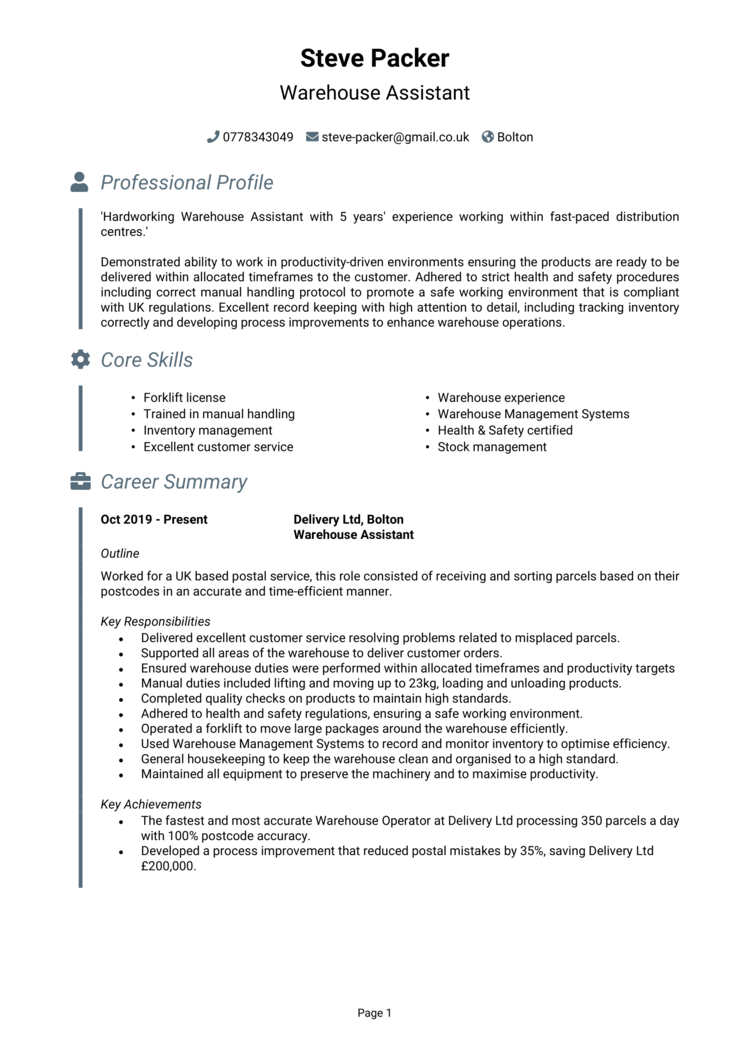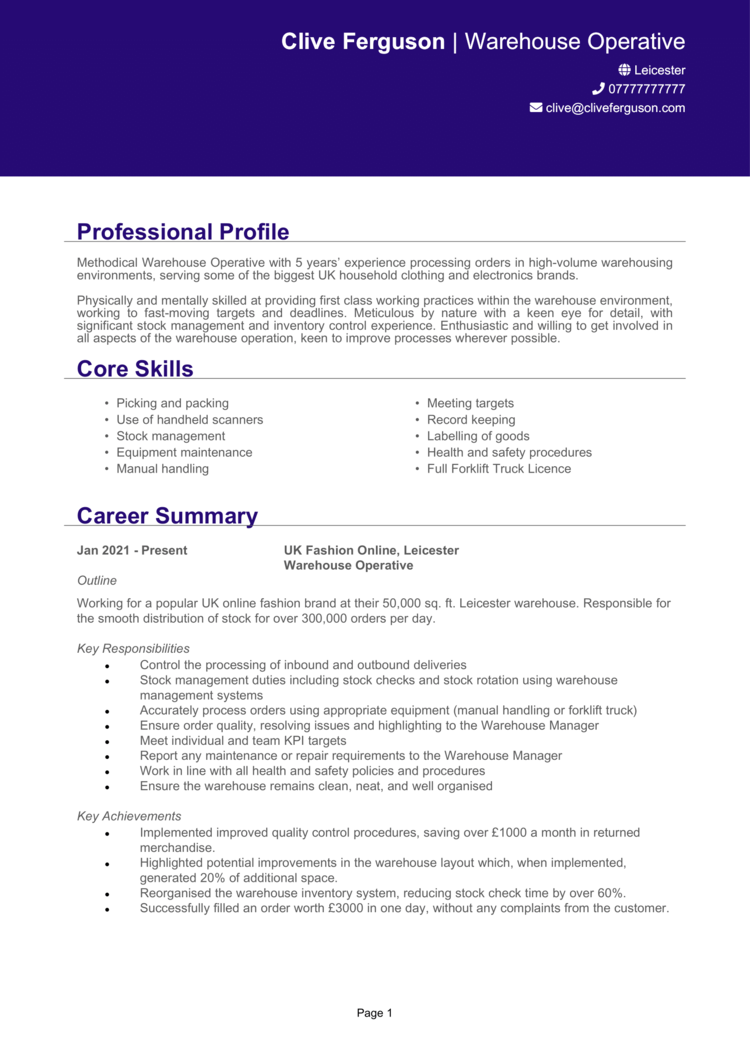You’re the person who makes sure the right things are in the right place at the right time – no drama or no delays. But your next job won’t land itself: you’ll need a CV that outlines why you’re the perfect fit.
Whether you’re just starting out or have years of warehouse experience under your belt, this guide and its Warehouse Assistant CV examples will help you put together a CV that’s as efficient and well-organised as any stockroom you’ve worked in.
Warehouse Assistant CV

Warehouse Operative CV

How to write your Warehouse Assistant CV
Discover how to craft a winning Warehouse Assistant CV that lands interviews with this simple step-by-step guide.
Warehouses don’t run on luck – they run on systems, schedules, and people who know how to keep things moving. If your CV is unclear or all over the place, hiring managers won’t stick around long enough to see how reliable you are.
This guide will show you how to lay out your skills and experience in a way that gets straight to the point – helping you with writing a CV full of tailored content that proves you’re the competent candidate hiring managers are looking for.
Structuring and formatting your Warehouse Assistant CV


Warehouse work is about keeping things in the right place – and your CV should follow that same logic. A clear structure helps hiring managers see what you’ve done, what you’re good at, and why they should bring you in for an interview: overwhelming them with a wall of disorganised text will only have them move onto the next applicant.
Here’s the layout to follow:
- Name and contact details – Display your contact details clearly at the top so employers can get in touch easily. Including a photo is entirely optional.
- Profile – Begin with a concise summary that highlights your expertise and what you bring to the role.
- Core skills – Highlight your strongest skills that align with the role’s requirements.
- Work experience – Start with your most recent role and work backwards, showcasing achievements and responsibilities.
- Education & certifications – Any relevant qualifications or warehouse-specific training.
- Additional info – Include any additional details, like awards, professional memberships, or hobbies that highlight your skills or personality.
Use bullet points to keep things skimmable, break the CV into clearly labelled sections, and choose a clean, readable font. Keep the whole thing to a maximum of two pages – long enough to show your skills, short enough to stay focused. A tidy and coherent CV format tells recruiters you’re ready to hit the ground running: so stick to these tips for a readable application.
The best way to write a Warehouse Assistant CV profile


Before anyone sees what you’ve done, they’ll read who you are – and your CV profile is where you prove you’re more than just a pair of hands on the warehouse floor. It’s your chance to show you’re dependable and already know how to make yourself useful from day one. The trick is to convince recruiters that hiring you would bring genuine benefit to the warehouse.
Warehouse Assistant CV profile examples
Profile 1
Hardworking and dependable Warehouse Assistant with three years of experience in fast-paced distribution centres. Skilled in picking, packing, and inventory checks, with a strong understanding of health and safety protocols. Proficient in using handheld scanners and warehouse management systems. Known for accuracy, teamwork, and maintaining a clean and organised work environment.
Profile 2
Reliable Warehouse Assistant with two years of experience supporting logistics and fulfilment operations. Adept at loading and unloading stock, managing deliveries, and preparing goods for dispatch. Physically fit, safety-conscious, and quick to adapt to changing priorities in a busy warehouse setting. Committed to efficiency and timely order completion.
Profile 3
Motivated Warehouse Assistant with experience in retail stockrooms and third-party logistics. Familiar with stock rotation, goods-in procedures, and basic forklift handling. Known for a strong work ethic, punctuality, and attention to detail. Eager to contribute to team success and maintain high standards of warehouse operations.
Details to put in your Warehouse Assistant CV profile
Here’s what to include:
- Where you’ve worked – Warehouses, distribution centres, supermarkets, or logistics firms.
- Your top qualifications – Any health & safety or manual handling training.
- Essential skills – Speed, accuracy, reliability, and teamwork.
- Equipment knowledge – If you’ve used forklifts, pallet trucks, or inventory systems.
- Work ethic – Show you’re someone who turns up, gets stuck in, and pulls your weight.
How to present your core skills section properly


This section is your CV’s “quick scan” zone – the bit recruiters will glance at to decide whether you’re worth calling. Don’t just copy and paste CV skills for the sake of it. Pick the ones that show you’re ready to get the job done – whether that’s your understanding of safety procedures, your knack for staying productive on long shifts, or your ability to keep up with targets.
Use the job description to tailor this list to what the employer wants, and you’ll be halfway to getting your foot in the loading bay.
Key skills that make a Warehouse Assistant CV stand out
- Order Picking and Packing – Accurately selecting items from inventory and securely packing them for dispatch.
- Stock Replenishment – Restocking shelves and bins to maintain efficient workflow and product availability.
- Inventory Control – Assisting with stock counts, recording inventory levels, and reporting discrepancies.
- Goods Receiving – Unloading deliveries, checking items against delivery notes, and updating inventory systems.
- Health and Safety Compliance – Following warehouse safety procedures, using PPE, and maintaining a clean, hazard-free environment.
- Equipment Operation – Using pallet jacks, hand trucks, or forklifts (if trained) to move goods safely around the warehouse.
- Labelling and Scanning – Applying barcodes and labels accurately and using handheld scanners to track stock movement.
- Returns Processing – Handling returned goods, checking condition, and preparing them for restocking or disposal.
- Warehouse Organisation – Keeping storage areas clean and organised to improve efficiency and accessibility.
- Team Collaboration – Working closely with supervisors and colleagues to meet daily shipping and receiving targets.
How to present your work experience in your CV


Here’s where you show that your experience isn’t just boxes ticked – it’s boxes packed, scanned, stacked, and shipped. Employers don’t want a wall of job titles; they want to know what you actually did and how well you did it.
Even if your past roles were similar, you can still tailor your descriptions to show you’ve grown, adapted, or worked in different environments. Think about the kinds of equipment you’ve used and the goals you’ve helped your team meet through previous work experience.
How should you list jobs on your Warehouse Assistant CV?

- Outline – Introduce the company and your role within the team.
- Responsibilities – Use action words like “picked,” “packed,” “loaded,” “received,” or “maintained” to explain your main tasks.
- Achievements – Highlight ways you made a difference: “Maintained 100% pick accuracy,” “Trained two new team members,” or “Helped reduce delivery turnaround time by 15%.”
Work history examples for Warehouse Assistants
Warehouse Assistant | Northbridge Logistics
Outline
Supported day-to-day operations at a regional distribution centre, assisting with goods handling, inventory checks, and order fulfilment.
Responsibilities
- Picked and packed customer orders using handheld scanners and packing equipment.
- Checked incoming deliveries for accuracy and reported any discrepancies.
- Organised stock in designated locations, ensuring safe and efficient storage.
- Maintained cleanliness and safety of the warehouse floor throughout shifts.
- Worked closely with supervisors and team members to meet daily dispatch targets.
Achievements
- Consistently met 100% accuracy targets for order picking.
- Recognised for reliability and teamwork during peak trading periods.
- Trained two new starters on picking processes and safety procedures.
Warehouse Assistant | Greenline Supply Co.
Outline
Assisted with stock management and order preparation for a national supplier of home goods and seasonal products.
Responsibilities
- Received, labelled, and stored deliveries in accordance with stock rotation procedures.
- Prepared pallets and packages for courier dispatch, following weight and labelling guidelines.
- Updated stock counts and records using the warehouse management system.
- Carried out general warehouse duties including waste disposal and restocking supplies.
- Operated pallet jacks and adhered to manual handling best practices.
Achievements
- Reduced packing errors by 20% by introducing a double-check system.
- Maintained an excellent attendance and punctuality record over 12 months.
- Selected to support weekend operations due to consistent performance and flexibility.
Warehouse Assistant | Urban Threads Retail
Outline
Worked in the warehouse team of a clothing retailer, supporting product intake, storage, and fulfilment for both online and retail store stock.
Responsibilities
- Unloaded and processed goods-in deliveries, ensuring items were checked and scanned correctly.
- Allocated stock to designated areas based on product category and store allocations.
- Prepared shipments for store replenishment and e-commerce orders.
- Assisted in stock counts and supported loss prevention efforts.
- Followed safety procedures and wore appropriate PPE at all times.
Achievements
- Helped improve delivery turnaround times by 15% during peak sale periods.
- Commended by supervisors for maintaining order and efficiency in stock zones.
- Completed manual handling and warehouse safety training with distinction.
Presenting your education history


Briefly list any qualifications you’ve earned, starting with your most recent. That could be GCSEs, college courses, or warehouse-specific training like manual handling, forklift certification, or COSHH awareness.
Recruiters prioritise your experience, so keep the education section concise and to-the-point: no need to list off every GCSE result.
Best qualifications for a Warehouse Assistant
- Level 2 Certificate in Warehousing and Storage – Offers a formal foundation in warehouse duties.
- Manual Handling Training Certificate – Shows awareness of safe lifting and movement.
- Forklift Truck Licence (e.g. Counterbalance or Reach) – Highly desirable in most warehouse settings.
- Health & Safety in the Workplace (Level 2) – Demonstrates basic safety knowledge.
- COSHH Training Certificate – Useful for handling hazardous materials or chemicals.





